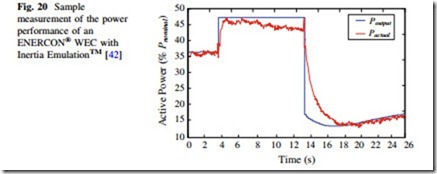Synthetic or Artificial Inertia
Modern WTGs use power electronics converters to enable variable speed operation in order to capture wind energy over a wide range of speeds. However, these converters isolate the rotational speed from the system frequency so WTG based on back-to-back AC–DC–AC converters offer no natural response to system frequency [36]. The adjective natural is included on the previous sentence because some manufacturers have started to integrate controllers on modern WTGs in order to provide inertial response (and governor response on some cases) for large, short- duration frequency deviations.
The wind turbine industry has created several names for this control system that enable inertial responses on a WTG [37, 38]: Artificial, Emulated, Simulated, or Synthetic Inertia.
Examples of synthetic inertia controlled commercially available for WTG are: General Electric WindINERTIATM [39, 40], ENERCON Inertia Emulation [41], Vestas, GE, etc.
ENERCON’s solution to contribute on frequency changes and especially to drops is named ENERCON® Inertia EmulationTM. This is an inertia controller, which uses the kinetic energy stored in the wind turbine rotor to temporarily provide extra amount of power (Pincrease). The minimum power of the WEC to enable Inertia EmulationTM is 4 % of rated power (Prated) and the maximum increase reached is 10 % of the nominal power for a maximum duration of 10 s. No stalling is triggered after the action of the Inertia EmulationTM system and the WEC gets twice the activation time, before a further activation is allowed. Figure shows a representative results of Inertia EmulationTM system.
Figure 20 shows a measurement of an ENERCON E-82/2 MW with Inertia Emulation, which was operating at partial load (*34 % rated power) where the active power output was temporarily increased by *10 % rated power to in total 44 % rated power without an increase in wind speed [42].
During the last few years, some TSOs and manufacturer have shown interest and collaborated to enable synthetic inertia in wind power generation.
ENERCON have cooperated with Hydro Québec and simulated frequency support controllers in the power system of Quebéc [43]. Hydro Québec was early
to require that a wind power plant must have an inertia emulation system that acts on major frequency deviations with a performance ‘‘at least as much as does the inertial response of a conventional synchronous generator whose inertia (H) equals 3.5 s.’’ A somewhat different definition of the requirements is then developed in cooperation with ENERCON and REpower. A controller defined with power increase, power decrease, and time for these actions is found to be a better option than requiring an equivalent inertia.
National grid (UK) has studied FR and synthetic inertia during the last few years and its Frequency Response Technical Sub-Group Report [44] recommended the fast FR instead of synthetic inertia. The active power reserve shall be fully available in 5.0 s and sustained for at least a further 25.0 s.
ENTSO-E Draft Requirements for Grid Connection [11, 45] stated that a type C unit (a synchronous generating unit or power park module connected below 110 kV and with a maximum capacity above 10 MW) without natural inertia may be required to provide synthetic inertia. The grid operator in cooperation with the TSO ‘‘shall have the right to require a power generating facility to deliver an equivalent performance by an increase of active power related to the rate of change of frequency’’.
Table 2 shows a general overview of inertia requirements for several countries around the world, it is clear that there are various opinions regarding synthetic inertia, how to define it, and what to require. The uncertainty leads to dissatis- faction among the wind turbine manufacturers. A problem is that general requirements are not easily defined as the entire system has to be taken into account. Different systems with different types of production and wind power penetration have different needs.
Currently, no grid code contains real tangible requirements—only few loose indications, and the inertia has not been reported as implemented in any commercial project yet. Together this seems to indicate that the need is not there currently.

